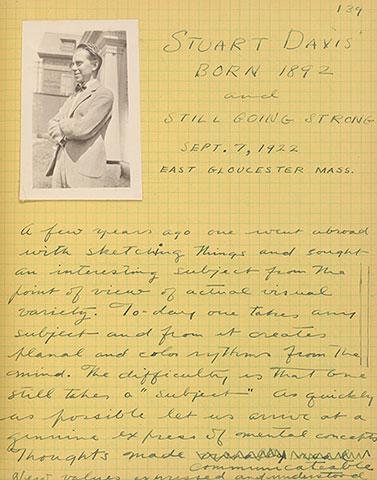
This is the earliest known diary kept by the American artist Stuart Davis (1892–1964). It represents the beginning of a lifelong practice of theoretical writing that would ultimately comprise some 10,000 pages of reflections, explorations, sketches, and diagrams that document his quest to break new ground in American art.
Davis chose a ledger book with yellow graph paper bound in marbled paper-covered boards, manufactured by the J.G. Shaw Blank Book Co., a stationer’s shop on Canal Street in New York. The notebook probably cost about $1 in 1920. Davis used the diary as an aesthetic workshop, a verbal companion to his drawing and painting, a space to explore the issues that would engage him for decades—the proper relationship between art and the physical world, the role of color in the visual image, the links between industry and art, and much more. He ached to “get away from the personal” and create fresh work that was complete on canvas. “In a word,” he instructed himself in one of the entries, “let whatever you do be a thing in itself and not a muddy reminder of daylight.”
Though Davis published widely in exhibition catalogs and periodicals, his extensive private writings—including this diary—remain largely unpublished. For further reading about Davis’s early work and writings, see Diane Kelder’s Stuart Davis: Art and Theory, 1920–31, the catalogue of a 2002 exhibition at the Morgan. The diary was also featured in the exhibition The Diary: Three Centuries of Private Lives (2011). A major collection of Davis’s papers, including thousands of pages of writings that continue the work he began in this diary, is held at the Harvard Art Museums.
Introduction by Christine Nelson, Drue Heinz Curator of Literary and Historical Manuscripts, 2020.
Stuart Davis
1892–1964
Autograph manuscript diary, 1920 May–1922 Nov. 28
Purchased on the Young Associates Fund
MA 5062
© Stuart Davis / Artists Rights Society (ARS), New York
